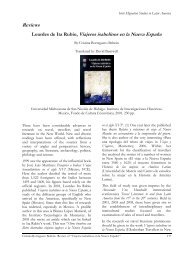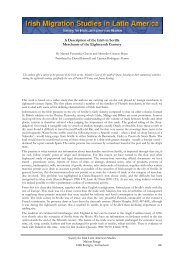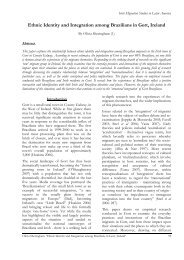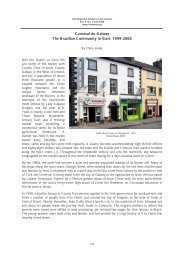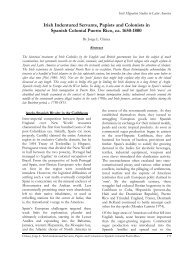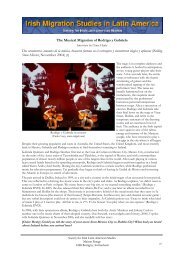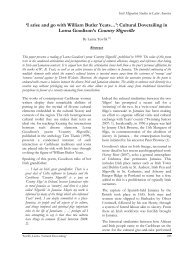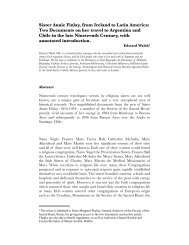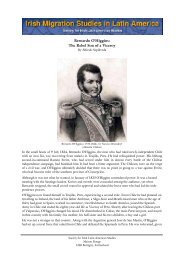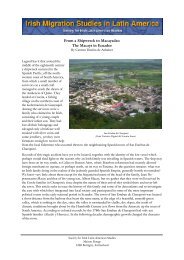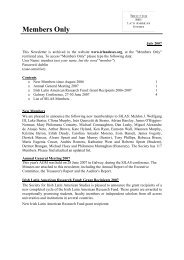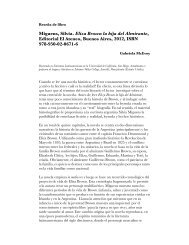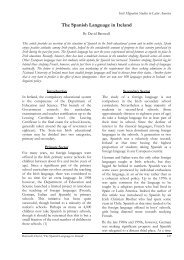I:6 Anti-dumping - Society for Irish Latin American Studies
I:6 Anti-dumping - Society for Irish Latin American Studies
I:6 Anti-dumping - Society for Irish Latin American Studies
You also want an ePaper? Increase the reach of your titles
YUMPU automatically turns print PDFs into web optimized ePapers that Google loves.
The Children of the Diaspora<br />
<strong>Irish</strong> Schools and Educators in Argentina, 1850-1950<br />
By María José Roger<br />
Introduction<br />
In the 1850s, Ireland, <strong>for</strong> centuries the “isle of saints and scholars”, could be rightfully considered one of<br />
the world’s leading producers of immigrants. Due to unsustainable living conditions that exceeded the<br />
much debated Great Famine, about 1.5 million <strong>Irish</strong>men left their country in search of a better future.<br />
Their first option was to cross the <strong>Irish</strong> Sea to England and join the scores of workers that fuelled the<br />
world’s leading economy. Others crossed the Atlantic and contributed to the rapid growth of the United<br />
States. There were some who ventured farther, to the scarcely populated British dominions: Canada,<br />
Australia and New Zealand.<br />
But there were those -a mere ten to twenty thousand men and women [1] - who chose another country<br />
which yearned <strong>for</strong> hard working immigrants that would position it as one of the leading nations in the<br />
world: the Argentine Republic.<br />
Through the 1840s and up to the 1860s, the landowners of the rich province of Buenos Aires hired skilled<br />
<strong>Irish</strong>men to tend to their sheep. Encouraged by fellow countrymen who had tried their luck in the pampas,<br />
entire families -primarily from Co. Westmeath, Wex<strong>for</strong>d and Long<strong>for</strong>d- arrived to find that, although the<br />
language and culture differed, they shared a common faith and they had the opportunity to become<br />
landowners.<br />
By 1870 approximately 85 % of the <strong>Irish</strong> immigrants were settled in the countryside. Through contracts<br />
that granted them a percentage of the sheep’s offspring, many shepherds created their own herds from<br />
scratch. They then leased land or bought it. Successful sheep farmers then became full fledged estancieros<br />
and mingled with the best of the Argentine society. However, these success stories became increasingly<br />
rare during the last quarter of the century … later arrivals were lucky enough to find a job with their fellow<br />
nationals.<br />
The remaining 15 % of <strong>Irish</strong> immigrants lived in the cities, especially in Buenos Aires: port of entry,<br />
capital city and economic engine of the young Republic. Women could easily find employment as maids<br />
and cooks, while men usually worked <strong>for</strong> commercial firms. The increasing prosperity of some estancieros<br />
meant that towards the 1880s they could af<strong>for</strong>d to have a house in the city.<br />
Buenos Aires was also the home of a key figure in the history of <strong>Irish</strong> immigration to Argentina: Reverend<br />
Anthony Fahy. This zealous Dominican arrived to Argentina in 1844, and during the next twenty-seven<br />
years, he laboured <strong>for</strong> the well being of his countrymen. His tasks were so varied that he once defined<br />
himself as “consul, post master, judge, pastor, interpreter and job provider” [2] . He advised many to go<br />
to the countryside, save money and then acquire their own lands.<br />
Thanks to the ef<strong>for</strong>ts of Fahy, other priests and the more <strong>for</strong>tunate members of the community the <strong>Irish</strong><br />
were able to <strong>for</strong>m their own community institutions and preserve their traditions. Local literature, music,<br />
sports, Argentine culture as a whole was enriched by the contributions of the <strong>Irish</strong>-Argentines. As we shall<br />
see throughout this article, education was greatly benefited by their ef<strong>for</strong>ts in the 1850-1950 period.<br />
Education in the Argentine Republic<br />
Since the times of the May Revolution (1810), education was one of the pillars of the Argentine Republic.<br />
Initially entrusted to private individuals, priests and religious congregations, it was gradually absorbed by<br />
<strong>Society</strong> <strong>for</strong> <strong>Irish</strong> <strong>Latin</strong> <strong>American</strong> <strong>Studies</strong><br />
Maison Rouge<br />
1268 Burtigny, Switzerland<br />
5



